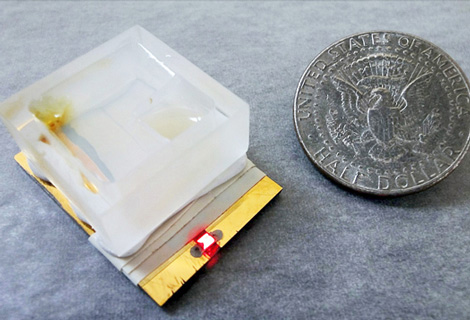Jell-O Now Detects Organ Failure

People who suffer from pancreatitis, a sudden inflammation of the pancreas, can experience severe stomach pain, nausea, fever, shock, and even death.
In order to detect pancreatitis quickly, biochemistry researchers at University of Texas at Austin have developed a sensor the size of a matchbox using only aluminum foil, gelatin, a 12-cent LED light, and a few other inexpensive materials.
The sensor relies on a two-step process to diagnose the disease. In step one, a bit of blood extract is dropped onto a layer of gelatin and milk protein. If there are high levels of trypsin, an enzyme that is overabundant in the blood of patients with acute pancreatitis, the trypsin will break down the gelatin in much the same way it breaks down proteins in the stomach.
In step two, a drop of sodium hydroxide (lye) is added. If the trypsin levels were high enough to break down that first barrier, the sodium hydroxide can trickle down to the second barrier, a strip of Reynold’s wrap, and go to work dissolving it.
The foil corrodes, and with both barriers now permeable, a circuit is able to form between a magnesium anode and an iron salt at the cathode. Enough current is generated to light up a red LED. If the LED lights up within an hour, acute pancreatitis is diagnosed.
The sensor has a number of potential uses, most notably in developing countries or after a natural disaster where more complex testing is difficult. The device’s speed also could make it worthwhile as a first-line measure, even in well-stocked hospitals.
Fun extra: check out this video of a gelatin cube being dropped onto a hard surface at 6,200 frames per second:
Image: University of Texas at Austin
Filed under: Biomedical, e-News
Tags: Biomedical








